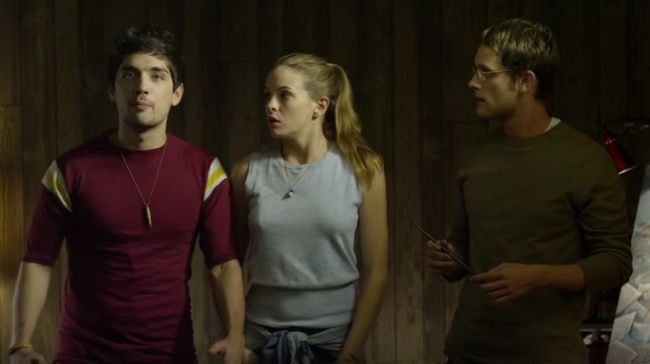
Time Lapse (2015) Review
Having control of time is not as great as these three people thought.
Time Lapse is 2015 science fiction thriller about three friends who discover a mysterious machine that takes pictures 24 hours into the future, though their plans to improve their lives proves increasingly disturbing.
In a secluded ranch home-style apartment complex, a trio of young friends live as the managers, even though they each have their own unrealized aspirations. Finn (Matt O’Leary), is a down on his luck oil painter who hasn’t sold his work in ages. Jasper (George Finn) is his best friend, a stoner, addicted to dog racing. Callie (Danielle Panabaker), is Finn’s girlfriend, a motherly-type who cooks and occasionally models for Finn.
When an older tenant appears to be missing, they enter his apartment and discover a wall filled with polaroid stills, each revealing an image of the trio’s front bay window and them inside. They are further confused by a large apparatus mounted to the floor that appears to be a massive camera pointed directly at their house. They soon realize however, that the machine is taking pictures of events one day in the future.
The three first believe the camera can bring them great personal gain, especially with Jasper, who now has the winnings for the day’s races, and sets about acquiring a small fortune. Unfortunately, this gains the attention of his bookie Ivan (Jason Spisak), who wants in as to how he’s doing it, which leads to some very dangerous options. What is seen in these pictures is less important than what is not though, and piecing together what happens in the future leads to some truly disturbing outcomes.
Written and directed by Bradley King, Time Lapse is an intriguing mystery that appears at first to be a time travel movie but is in fact, anything but. A morality play with three main actors, it uses the tropes of the genre it falls under to paint a story about very different people who should not be anywhere near each other. King keeps this low key, filmed primarily within the confines of one room, only venturing out across the way to visit the story’s MacGuffin in order to set up the next stage in the sequence. It’s an effective method that helps to create a sense of claustrophobia in the plot but better in establishing the Twilight Zone-esque feel of the narrative, as if these people exist only in a universe they alone occupy.

The three leads are each a highly-specific archetype that purposefully play against the other, each drawing out the baser impulses of the others, with Finn the creative one stumped by his closed view, Callie the deceptive player, manipulating to serve her own ends, and Jasper, the reactionary, greedily thinking of the immediate rather than the long-term. What they all suffer from is a larger intelligence and awareness of the cards they have been dealt, none seeing what is the greatest breakthrough in human technology for its full potential, but rather narrowly confining its power to a far lesser scale.
King very cleverly uses the large white borders of the trio’s living room window to look like the frame of a picture so that each image snapped by the machine appears like a portrait. This has great effect in playing to the plot’s theme that there are things beyond what is seen that might be reason for what is in the image. This is eluded to often as each day the three slowly dividing friends try and guess as to why and how they end up as the future picture reveals, though convinced that deviating from what is shown will prove more catastrophic than what they see. What we as a viewer need to do is to constantly watch carefully for who is saying what, and like the players in the movie, try to understand their motivations.
Time Lapse is generally a smart little film, though hindered by its lack of momentum, which actually slows as the story progresses. The subplot of Jasper’s bookie stretches for too long, with Spisak over-doing the slime-ball stereotype to laughable levels, and there is no chemistry between the three leads, especially between O’Leary, who is flat throughout, and Panabaker, who, despite being the most energizing of the three, can’t convince that she would be attracted to either of these men.
That said, the premise is clever and there is enough ambiguity to it to merit some fun questions afterward, most notably, how reliable are the images and is the future controlling the past or is the past dictating the future? It leaves you with a sense that you might have missed something and that perhaps there are clues still hiding in the corners, which in a film like this, is exactly right.
